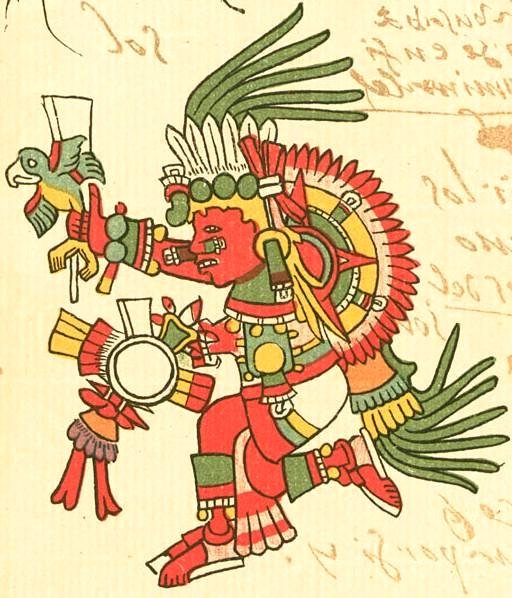

A special altar to the sun was used for sacrifices in coronation rites, a fact that signifies the importance of the deity. The warriors were charged with the mission to provide the sun with sacrificial victims. TONATIUH, the sun, was perceived as a primary source of life whose special devotees were the warriors.

In Tenochtitlan another Tlaloc temple shared the platform atop the dual Main Pyramid, a symbolic mountain. Tlaloc, where human victims were sacrificed to fertilize water-rocks within the sacred enclosure. The primary temple of this major deity was located atop Mt. The name may be Aztec, but the idea of a storm god especially identified with mountaintop shrines and life-giving rain was certainly as old as Teotihuacan. TLALOC, the rain deity, belonged to another most memorable and universal cult of ancient Mexico.

His cult was particularly identified with royalty, for Tezcatlipoca was the object of the lengthy and reverent prayers in rites of kingship. TEZCATLIPOCA, (god of Night and Sorcery) "Smoking Mirror" (obsidian), characterized as the most powerful, supreme deity, was associated with the notion of destiny. The image of the serpent rising from the earth and bearing water on its tail is explained in the Nahuatl language by a description of Quetzalcoatl in terms of the rise of a powerful thunderstorm sweeping down, with wind raising dust before bringing rain.

But its most fundamental significance as a natural force is symbolized by the sculpture of a coiled plumed serpent rising from a base whose underside is carved with the symbols of the earth deity and Tlaloc. It was the name of a deity, a royal title, the name of a legendary priest-ruler, a title of high priestly office. QUETZALCOATL, (the god of civilization and learning) "quetzal (feather) serpent," had dozens of associations. OMETECUHLTI and his wife OMECIHUATL created all life in the world. Victims' heads were strung as trophies on a great rack, the Tzompantli, erected in the precinct below. His temple (next to that of Tlaloc) on the Main Pyramid was the focus of fearsome sacrifices of prisoners captured by Aztec warriors. HUITZILOPOCHTLI, (the war/sun god and special guardian of Tenochtitlan) the deified ancestral warrior-hero, was the Mexica-Aztec patron par excellence. The maintenance of fires in the temples was a principal priestly duty, and the renewal of fire was identified with the renewal of time itself. HUEHUETEOTL, "the old, old deity," was one of the names of the cult of fire, among the oldest in Mesoamerica. The people had many agricultural gods because their culture was based heavily on farming also they included natural elements and ancestor-heroes. They worshipped hundreds of gods and goddesses, each of whom ruled one or more human activities or aspects of nature. Religion was extremely important in Aztec life. The yearly round of rites and ceremonies in the cities of Tenochtitlan and neighboring Tetzcoco, and their symbolic art and architecture, gave expression to an ancient awareness of the interdependence of nature and humanity. As early texts and modern archaeology continue to reveal, beyond their conquests and many of their religious practices, there were many positive achievements: the formation of a highly specialized and stratified society and an imperial administration, the expansion of a trading network as well as a tribute system, the development and maintenance of a sophisticated agricultural economy, carefully adjusted to the land and the cultivation of an intellectual and religious outlook that held society to be an integral part of the cosmos. The Aztecs of Mexicas The Aztecs / Mexicas were the Indigenous people who dominated northern Mexico at the time of the Spanish conquest led by Hernan CORTES in the early 16th century.įearless warriors and pragmatic builders, the Aztecs created an empire during the 15th century that was surpassed in size in the Americas only by that of the Incas in Peru.


 0 kommentar(er)
0 kommentar(er)
